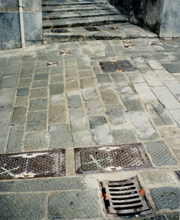Summer in Italy, Genoa, August 2001 feels like a hot season holiday that turned sour and, apart from one literal memento mori,
there is little summer sun or political heat to be felt in the pictures themselves. The series is a catalogue of absence, a conceptual work that on the
one hand makes use of photography’s ability to approximate reality and on the other the ability of our brains to make the necessary captions and connections.
As such the relatively bland  surface,
like the implications of the welded-down drain covers, is one of suppressed threat, of containment, security measures and violence. That, of course,
has to do with interpretation - with the photographs and their context. surface,
like the implications of the welded-down drain covers, is one of suppressed threat, of containment, security measures and violence. That, of course,
has to do with interpretation - with the photographs and their context.
The series was provoked by the G-8 summit in Genoa and the fate of the Volx Theater Karawane (People’s Theatre Caravan). As critics
of globalisation who were on the “No Border, No Nation” tour concerning deportation arrest, illegality and borders, they took part in the demonstrations
which took place in Genoa. Having lost control of the situation, the Italian police took revenge in a campaign of violence. The independent media centre
was trashed, computers confiscated, arrests made and in the Diaz School sleeping people were brutally beaten, some of whom were still in their sleeping
bags. One student (Carlo Guiliani) was shot - twice - in the head. Gay protestors dressed as teddy bears were truncheon whipped. and later said to be
part of a so-called “Black Block” who dressed in that colour. |
 |
|
The police, who found it effective in the media to label protestors as “professional” trouble-makers; “Black
Block” terrorists and the like were not professional enough themselves to be able to discriminate between furry animal costumes and a dark T-shirts -
and woe betide you if your black T-shirt was just a fashion statement - between sleeping protestors and a immediate, physical threat to their own safety.
The point here is that the whole turmoil - including the national and EU calls for greater surveillance of “might-be” protestors, measures to make it
more difficult for them to travel etc. - the debates around globalisation and its consequences are not to be seen in the photos. Although photographic
reality (re)occupies the territory, its role here is almost forensic - a collection of evidence: turning up wreathes of remembrance, traces of blood,
lock-downs, lock-outs and seal-ups - cover-ups, even. |